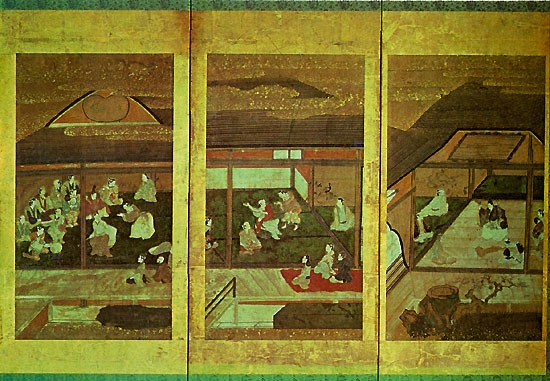| << UbuWeb |
| Aspen no. 10, item 11 |
|
|
| Noh and Kyogen Plays |

|
Noh and Kyogen Plays
Anonymous. Edo period,
Three panels of a six-fold screen depicting Noh and Kyogen plays. Color and gold on paper; H. 32 1/4 in., W. 99 in. From the collection of Mr. Martin Carr, displayed in the 1971 exhibition of Japanese screens at Asian House, New York City. |
""The story tells how on one occasion during his long Indian ministry the original Buddha, Siddhartha Gautama, was seated before a large assembly of people who had gathered from far and wide to hear him preach "the Law." The Buddha, remaining silent, took up a flower he had been given and quietly held it in his hand. Everyone in the congregation was puzzled by his silence and his deliberate gesture with the flower except one disciple, Kashyapa, who, looking at the golden blossom in the Teacher's hand, softly smiled. In this special inward smile the Buddha read Kashyapa's understanding of 'that which goes beyond the word' or 'the doctrine of thought transmitted by thought'... ""To this day the canon of judgment brought to bear on a performance of Japan's ancient Noh drama (a theater rooted in Zen concepts) is whether it does or does not possess "the true flower," which is to say, whether it does or does not express that which is indescribable, ineffable, but plainly 'visible' to those with insight."(1) Noh drama dates from the 14th century and is the oldest of the theater arts performed today. Behind the plays, as behind haiku, are the teachings of Buddhism, both in the use of Zen ideas and in the form of the Noh itself — the bareness of the lines of the drama, the simplicity of the stage and sets where every "property" has been abstracted to a mere symbol; the artful use of emptiness and silence. |
""The Noh explores time and space in ways unfamiliar to our Western aesthetic and certainly far removed from our concepts of 'theatricality.'... the eerie use of the human voice in which normal breathing has been artfully suppressed; the occasional long-drawn, sad and solitary notes of a flute; the periodic sharp cries and catlike yowls from the chorus; the abrupt clack of sticks and the varied tonality of the three kinds of drum; the gliding ghostly dances... the extravagant and lavish costumes, the unreal reality of the wooden masks worn by the participants — these are a few of the traditional elements that help to create the special magic of Noh."(2) A complete evening of the serious, often tragic Noh drama lasts six hours. To relieve the solemnity, Kyogen plays are presented as comic relief between the Noh sections and often parody the pieces that follow them. Thus on the screen reproduced here, the first and third panels depict scenes from two Noh plays while the center panel shows a Kyogen. 1. Nancy Wilson Ross, "Three Ways of Asian Wisdom" (Simon & Schuster), p. 150. 2. Nancy Wilson Ross, "The World of Zen" (Random House), pp. 167-8. |
||||
|
© Aspen No. 10, Section 11 |
|
Original format: Single sheet printed both sides, 8 5/8 by 6 3/4 inches. |
|
|
|
|
|
|
|